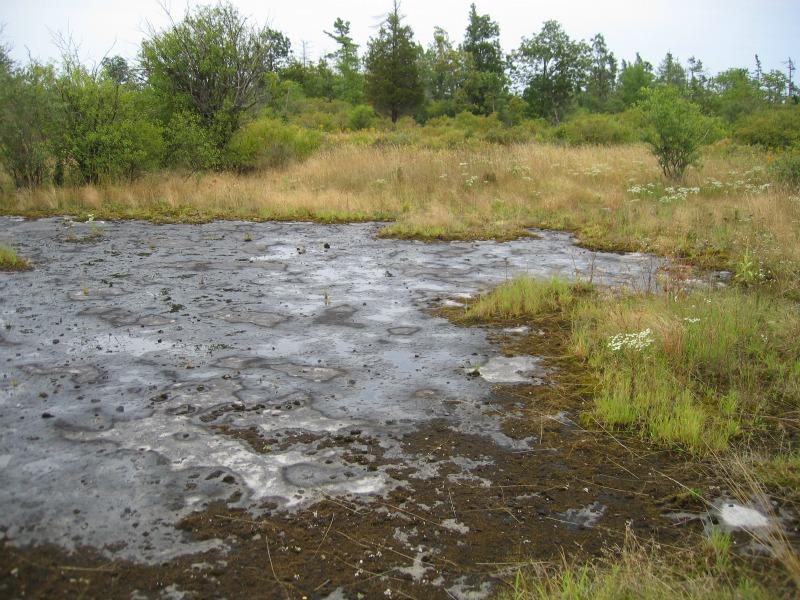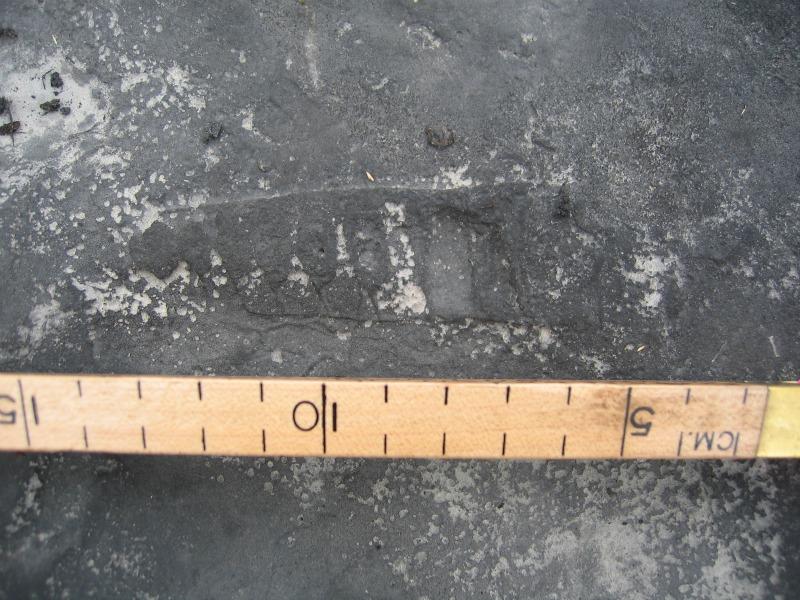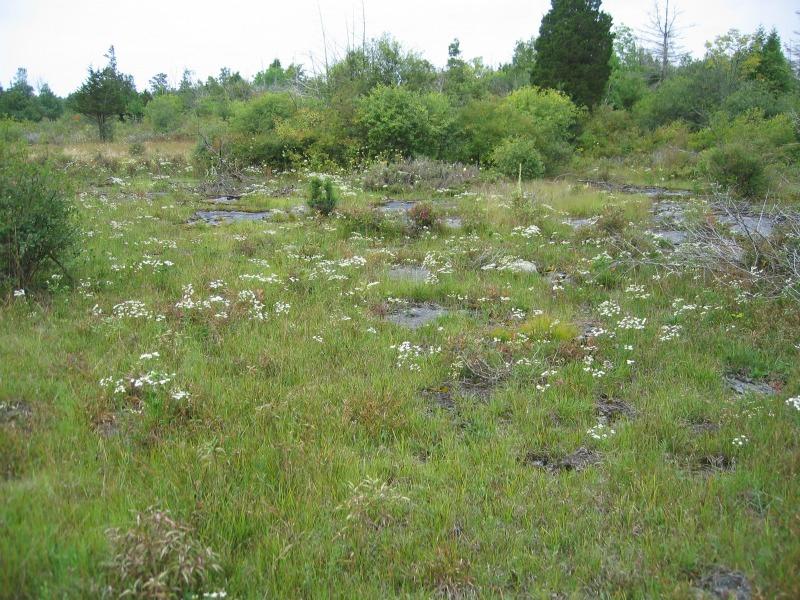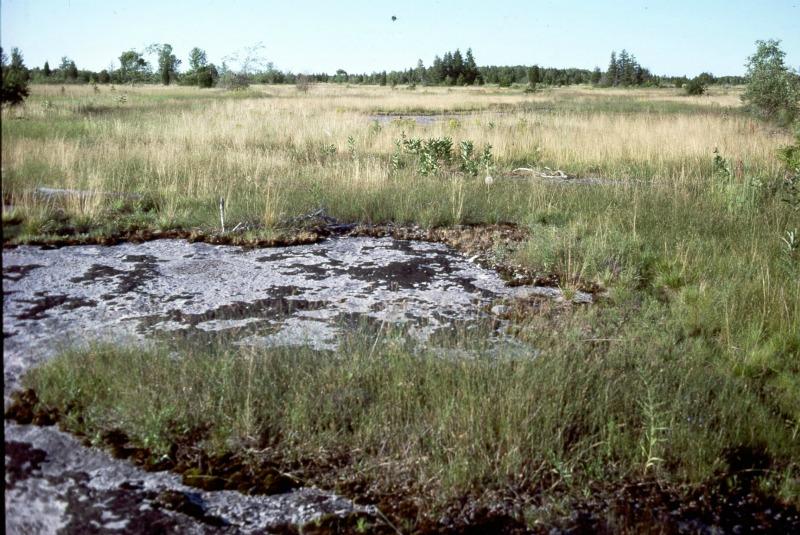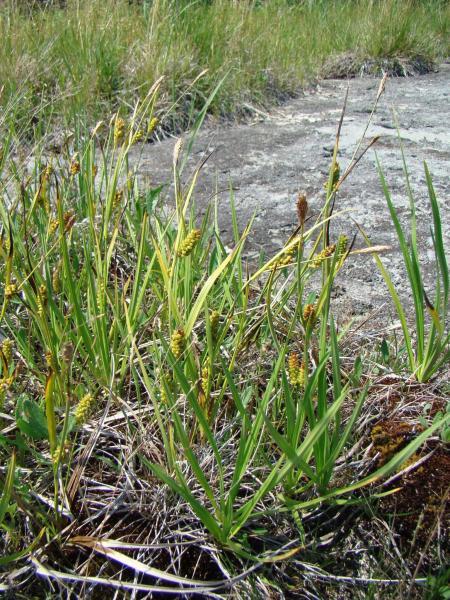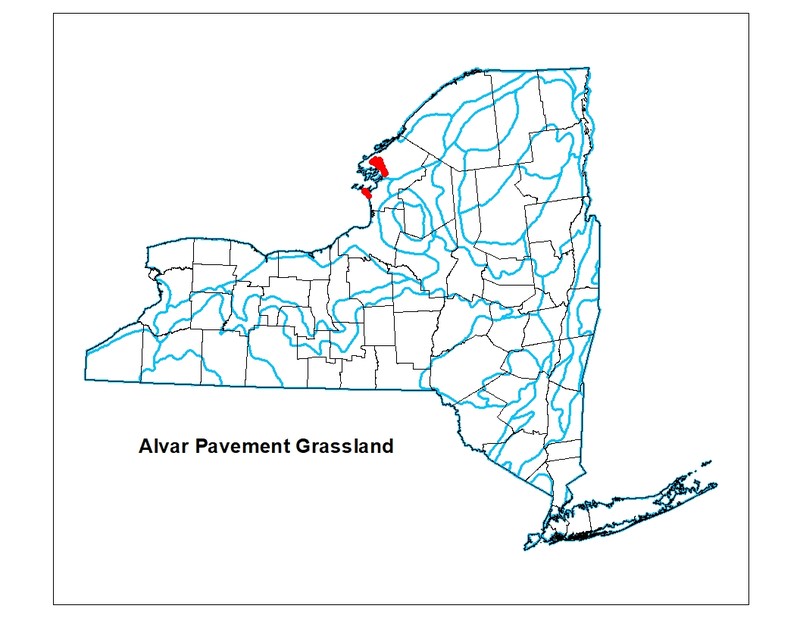Alvar Pavement Grassland
- System
- Terrestrial
- Subsystem
- Open Uplands
- State Protection
- Not Listed
Not listed or protected by New York State.
- Federal Protection
- Not Listed
- State Conservation Status Rank
- S2
Imperiled in New York - Very vulnerable to disappearing from New York due to rarity or other factors; typically 6 to 20 populations or locations in New York, very few individuals, very restricted range, few remaining acres (or miles of stream), and/or steep declines.
- Global Conservation Status Rank
- G2
Imperiled globally - At high risk of extinction due to rarity or other factors; typically 20 or fewer populations or locations in the world, very few individuals, very restricted range, few remaining acres (or miles of stream), and/or steep declines.
Summary
Did you know?
Alvar is a Swedish term to describe barrens and grassland vegetation growing on thin soils over level outcrops of limestone or dolomite bedrock. Grikes are the fissures, cracks, and crevices in limestone pavement bedrock created by the dissolution of limestone, especially in alvar communities. This community is limited to areas in Jefferson County underlain with Chaumont limestone (Galoo-Rock outcrop complex).
State Ranking Justification
There are probably much less than 30 occurrences statewide. A few documented occurrences have good viability and several are protected on public land or private conservation land. This community is limited to areas in Jefferson County underlain with Chaumont limestone (Galoo-Rock outcrop complex), and there are only a few high quality examples. The current trend of this community is probably stable for occurrences on public land and private conservation land, or declining slightly elsewhere due to moderate threats that include conversion to pastureland, development, trampling by visitors, ATVs, and invasive species.
Short-term Trends
It is estimated that alvar pavement grassland acreage has declined 10-30% within the last 100 years.
Long-term Trends
The current acreage is estimated to be less than half of the historical acreage.
Conservation and Management
Threats
Threats to alvar pavement grasslands include the invasion of exotic plants (in particular pale swallow-wort, buckthorn, and honeysuckles), grazing, trampling (especially ATV damage), hydrologic alterations, and development pressure in Jefferson County.
Conservation Strategies and Management Practices
Maintain the mosaic proportional distribution of existing alvar communities by ensuring the the pavement areas and grasslands are kept open. Alvar communities seem to require seasonal flooding, and maintenance of the natural hydrologic regime is critical. Take measures to exclude use of sites by ATVs. Prescribed fire may be a useful tool to promote native plant species diversity (care should be taken in selecting sites for its introduction) and the maintanence of open site conditions (Kost et al. 2007). Develop and implement a prescribed burn plan at appropriate sites. Improve the condition of existing alvar communities by reducing and/or eliminating invasive species, such as black swallow-wort (Cynanchum louiseae), Morrow's honeysuckle (Lonicera morrowii), and buckthorn (Rhamnus cathartica). Identify and target areas with early infestations of invasive exotic plants for control and eradication. Improve the condition of the alvar communities by minimizing trail network and clearly marking existing trails. Improve the landscape context of the barrens by encouraging surrounding landowners to establish natural buffers and restore natural corridors to other larger natural landscape blocks.
Development and Mitigation Considerations
Soils are very thin or lacking in and around this community and the effect of clearing and construction on soil retention and erosion must be considered during any development activities. Similarly, these pavements have wide cracks and fissures and any soil enrichment contamination (e.g., from septic leach fields and fertilized lawns) may rapidly alter the water quality of underlying aquifers as well as altering the barrens community structure and function.
Inventory Needs
The alvar communities in Jefferson County need to be inventoried and remapped using the current classification of alvar communities: 1) alvar pavement grassland, 2) alvar shrubland, 3) alvar woodland, 4) dry alvar grassland, and 5) wet alvar grassland. Survey for additional occurrences in Jefferson County and the surrounding region to advance documentation and classification of alvar pavement grasslands. Continue searching for large sites in excellent to good condition (A- to AB-ranked). Periodic inventory of the alvar pavement grasslands is needed, in order to keep occurrence data current. Quantitative data on composition and variability among patches within occurrences are needed from surveys throughout the growing season. Surveys for rare and characteristic invertebrate species (especially butterflies and moths, along with terrestrial molluscs) are needed for many sites.
Research Needs
Research the composition of alvar pavement grassland in Jefferson County in order to characterize variations and distinguish it from other alvar communities. Studies of the hydrology of alvar communities (a past study was conducted at Chaumont Barrens) and their immediately surrounding landscape are needed to better understand their hydrologic regimes. Continue long-term monitoring of deer browsing and grazing impacts. Establish a monitoring progam at various sites to understand and track the development of impacts from global climate change. Identify areas where fire can be implemented and evaluated as a management tool, including a flora and fauna monitoring component (Reschke et al. 1999).
Rare Species
- Anticlea elegans var. glauca (White Death Camas) (guide)
- Boechera grahamii (Graham's Rock Cress) (guide)
- Botrychium neolunaria (Common Moonwort) (guide)
- Botrychium rugulosum (Rugulose Grape Fern) (guide)
- Bouteloua curtipendula var. curtipendula (Side Oats Grama) (guide)
- Carex backii (Back's Sedge) (guide)
- Carex crawei (Crawe's Sedge) (guide)
- Carex garberi (Elk Sedge) (guide)
- Carex molesta (Troublesome Sedge) (guide)
- Castilleja coccinea (Indian Paintbrush) (guide)
- Cirriphyllum piliferum (Hair-pointed Moss) (guide)
- Corydalis aurea (Golden Corydalis) (guide)
- Descurainia pinnata ssp. brachycarpa (Northern Tansy Mustard) (guide)
- Draba arabisans (Rock Whitlow Grass) (guide)
- Dracocephalum parviflorum (American Dragonhead) (guide)
- Epilobium hornemannii ssp. hornemannii (Alpine Willowherb) (guide)
- Gentianopsis virgata (Lesser Fringed Gentian) (guide)
- Geum triflorum var. triflorum (Prairie Smoke) (guide)
- Hedeoma hispida (Rough Pennyroyal) (guide)
- Lilium michiganense (Michigan Lily) (guide)
- Myurella julacea (Small Mousetail Moss) (guide)
- Panicum flexile (Wiry Witch Grass) (guide)
- Platydictya jungermannioides (False Willow Moss) (guide)
- Pseudocalliergon turgescens (Curving Feather Moss) (guide)
- Spiranthes magnicamporum (Great Plains Ladies' Tresses) (guide)
- Sporobolus heterolepis (Prairie Dropseed) (guide)
- Symphyotrichum ciliolatum (Lindley's Aster) (guide)
- Ulmus thomasii (Rock Elm) (guide)
- Valerianella chenopodiifolia (Goosefoot Cornsalad) (guide)
Range
New York State Distribution
Restricted to outcrops of Chaumont limestone (Galoo-Rock outcrop complex) in Jefferson County. New York's sites are at the easternmost edge of a narrow range extending across southern Ontario to the eastern edge of northern Michigan. There are about 54 square miles (34,368 acres) of Galoo-Rock outcrop complex mapped in Jefferson County in the Soil Survey Geographic (SSURGO) database for New York.
Global Distribution
Alvar pavement grasslands occur in Ontario, Michigan, and New York in the central and eastern Great Lakes region (NatureServe Explorer 2015).
Best Places to See
- Chaumont Barrens Preserve (Jefferson County)
- Ashland Flats WMA (Jefferson County)
- Limerick Cedars Preserve (Jefferson County)
Identification Comments
General Description
There is usually less than 10% cover of shrubs. There may be nearly equal cover of grassy vegetation, and exposed rock covered with nonvascular plants. Lichens and mosses are common on "pavement" rock outcrops that occur as patches within this mosaic. The mosaic pavement and grassland association is dominated by small rush grass (Sporobolus neglectus), sheathed rush grass (S. vaginiflorus), Philadelphia panic grass (Panicum philadelphicum), Canada bluegrass (Poa compressa), upland white aster (Oligoneuron album), poverty grass (Danthonia spicata), false pennyroyal (Trichostema brachiatum), balsam ragwort (Packera paupercula), Crawe's sedge (Carex crawei), and wiry panic grass (Panicum flexile).
Characters Most Useful for Identification
This community is comprised of two vegetation associations; the first is a mosaic of pavement and grassland areas dominated by characteristic native species; the second consists of exposed, flat limestone or dolostone pavement that is sparsely vegetated with a mosaic of mossy patches and exposed bedrock that is covered with crustose and foliose lichens. Alvar pavement grasslands occur on Chaumont limestone (Galoo-Rock outcrop complex).
Elevation Range
Known examples of this community have been found at elevations between 249 feet and 400 feet.
Best Time to See
In late May, visitors can enjoy a diverse succession of native wildflowers in bloom, especially prairie smoke, which can be seen nowhere else in the northeast.
Alvar Pavement Grassland Images
Classification
International Vegetation Classification Associations
This New York natural community encompasses all or part of the concept of the following International Vegetation Classification (IVC) natural community associations. These are often described at finer resolution than New York's natural communities. The IVC is developed and maintained by NatureServe.
- Barrens Dropseed - Poverty Dropseed - Fluxweed - Philadelphia Panicgrass - (Canada Bluegrass) Alvar Grassland (CEGL005235)
- Twisted Moss - Cup Lichen - Black-thread Lichen species Sparse Vegetation (CEGL005192)
NatureServe Ecological Systems
This New York natural community falls into the following ecological system(s). Ecological systems are often described at a coarser resolution than New York's natural communities and tend to represent clusters of associations found in similar environments. The ecological systems project is developed and maintained by NatureServe.
- Great Lakes Alvar (CES201.721)
Characteristic Species
-
Trees > 5m
- Betula papyrifera (paper birch)
- Juglans cinerea (butternut)
- Juniperus virginiana var. virginiana (eastern red cedar)
- Picea glauca (white spruce)
- Thuja occidentalis (northern white cedar, arbor vitae)
-
Shrubs < 2m
- Juniperus communis var. depressa (American common juniper, ground juniper)
- Symphoricarpos albus var. albus (common snowberry)
-
Short vines
- Vitis riparia (river grape, frost grape)
-
Herbs
- Aquilegia canadensis (wild columbine, red columbine)
- Carex crawei (Crawe's sedge)
- Danthonia spicata (poverty grass)
- Fragaria virginiana ssp. virginiana (common wild strawberry)
- Houstonia longifolia (long-leaved bluets)
- Micranthes virginiensis (early-saxifrage)
- Packera paupercula (balsam groundsel)
- Panicum flexile (wiry witch grass)
- Panicum philadelphicum ssp. philadelphicum (Philadelphia witch grass)
- Penstemon hirsutus (hairy beard-tongue)
- Pilosella officinarum (mouse-ear hawkweed)
- Poa compressa (flat-stemmed blue grass, Canada blue grass)
- Potentilla norvegica (ternate-leaved cinquefoil)
- Sabulina michauxii var. michauxii (rock-sandwort)
- Solidago nemoralis ssp. nemoralis (gray goldenrod)
- Solidago ptarmicoides (upland white flat-topped-goldenrod)
- Sporobolus neglectus (small dropseed)
- Sporobolus vaginiflorus var. vaginiflorus (poverty dropseed)
- Trichostema brachiatum (false pennyroyal)
-
Nonvascular plants
- Cladonia pocillum
- Dermatocarpon miniatum
- Placynthium nigrum
- Tortella tortuosa
- Tortula ruralis
Similar Ecological Communities
- Alvar shrubland
(guide)
Alvar shrublands have over 25% cover of dwarf, short, and tall shrubs (avg. 43% cover of shrubs). Alvar pavement grasslands are dominated by herbaceous and nonvascular plants and usually have less than 10% cover of shrubs.
- Alvar woodland
(guide)
Alvar woodlands have over 25% cover of trees 5 m or taller. Alvar pavement grasslands typically lack trees, but a few sparsely scattered trees may grow in the cracks of the limestone pavement.
- Dry alvar grassland
(guide)
Dry alvar grasslands are dominated by poverty grass (Danthonia spicata). Alvar pavement grasslands are dominated by a mix of species. Poverty grass may be present, but is not dominant. Both communities may have flat limestone areas covered with nonvascular plants.
- Successional northern sandplain grassland
(guide)
Successional northern sandplain grasslands occur on sandy soil and are dominated by bluestem (Schizachyrium scoparium), hairgrass (Avenella flexuosa), Pennsylvania sedge (Carex pensylvanica), poverty grass (Danthonia spicata), and panic grasses (Dichanthelium spp.). Alvar pavement grasslands occur on Chaumont limestone (Galoo-Rock outcrop complex) and are dominated by small rush grass (Sporobolus neglectus), sheathed rush grass (S. vaginiflorus), Philadelphia panic grass (Panicum philadelphicum), Canada bluegrass (Poa compressa), upland white aster (Oligoneuron album), poverty grass (Danthonia spicata), false pennyroyal (Trichostema brachiatum), balsam ragwort (Packera paupercula), Crawe's sedge (Carex crawei), and wiry panic grass (Panicum flexile).
- Wet alvar grassland
(guide)
Wet alvar grasslands are dominated by tufted hairgrass (Deschampsia cespitosa), Crawe's sedge (Carex crawei), prairie dropseed (Sporobolus heterolepis), and flat-stemmed spikerush (Eleocharis elliptica var. elliptica). They occupy the lowest, wettest position in the alvar landscape. Typically the vascular vegetion is more continuous and the open pavement areas are lacking compared to alvar pavement grasslands.
Vegetation
Percent cover
This figure helps visualize the structure and "look" or "feel" of a typical Alvar Pavement Grassland. Each bar represents the amount of "coverage" for all the species growing at that height. Because layers overlap (shrubs may grow under trees, for example), the shaded regions can add up to more than 100%.
Additional Resources
References
Edinger, G. J., D. J. Evans, S. Gebauer, T. G. Howard, D. M. Hunt, and A. M. Olivero (editors). 2014. Ecological Communities of New York State. Second Edition. A revised and expanded edition of Carol Reschke’s Ecological Communities of New York State. New York Natural Heritage Program, New York State Department of Environmental Conservation, Albany, NY. https://www.nynhp.org/ecological-communities/
Edinger, Gregory J., D.J. Evans, Shane Gebauer, Timothy G. Howard, David M. Hunt, and Adele M. Olivero (editors). 2002. Ecological Communities of New York State. Second Edition. A revised and expanded edition of Carol Reschke's Ecological Communities of New York State. (Draft for review). New York Natural Heritage Program, New York State Department of Environmental Conservation. Albany, NY. 136 pp.
Gilman, B. 1998. Alvars of New York: a site summary. Finger Lakes Community College. Canadaigua, NY.
NatureServe. 2015. NatureServe Explorer: An online encyclopedia of life [web application]. Version 7.1. NatureServe, Arlington, Virginia. Available http://www.natureserve.org/explorer.
New York Natural Heritage Program. 2024. New York Natural Heritage Program Databases. Albany, NY.
Reschke, C., R. Reid, J. Jones, T. Feeney, and H. Potter. 1999. Conserving Great Lakes Alvars: final technical report of the International Alvar Conservation Initiative. The Nature Conservancy, Great Lakes Program, Chicago, IL.
Reschke, Carol. 1990. Ecological communities of New York State. New York Natural Heritage Program, New York State Department of Environmental Conservation. Latham, NY. 96 pp. plus xi.
Links
- Conserving Great Lakes Alvars: final technical report of the International Alvar Conservation Initiative (Reschke et al. 1999).
- EPA Great Lakes Ecological Protection and Restoration Conserving Great Lakes Alvars
- NYS DEC Habitat Management Plan for Ashland Flats Wildlife Management Area
- The Nature Conservancy, New York, Chaumont Barrens Preserve
About This Guide
This guide was authored by: Gregory J. Edinger
Information for this guide was last updated on: January 23, 2024
Please cite this page as:
New York Natural Heritage Program. 2024.
Online Conservation Guide for
Alvar pavement grassland.
Available from: https://guides.nynhp.org/alvar-pavement-grassland/.
Accessed July 27, 2024.
